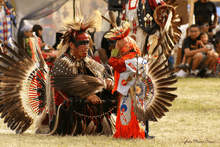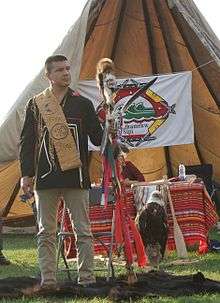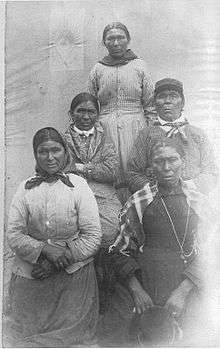Atikamekw
The Atikamekw are the Indigenous inhabitants of the subnational country or territory called Nitaskinan ("Our Land"), in the upper Saint-Maurice River valley of Quebec (about 300 kilometres (190 mi) north of Montreal), Canada. Their population currently stands at around 8,000. One of the main communities is Manawan, about 160 kilometres (99 mi) northeast of Montreal. They have a tradition of agriculture as well as fishing, hunting and gathering. They have close traditional ties with the Innu people, who were their historical allies against the Inuit.
 | |
| Total population | |
|---|---|
| 8,005[1] | |
| Regions with significant populations | |
| Languages | |
| Atikamekw, French | |
| Religion | |
| Catholic Church, Other, None | |
| Related ethnic groups | |
First Nations
|
The Atikamekw language, a variety of the Cree language in the Algic family, is in everyday use, making it therefore among the indigenous languages least threatened with extinction.[2] But their home land has largely been appropriated by logging companies and their ancient way of life is almost extinct. Their name, which literally means "lake whitefish", is sometimes also spelt "Atihkamekw", "Attikamekw", "Attikamek", or "Atikamek". The French colonists referred to them as Têtes-de-Boules, meaning "Ball-Heads" or "Round-Heads".
A small number of families make their living making traditional birch bark baskets and canoes.
Population

| Communities | First Nation official name | Total registered population |
Residents | Non-residents |
|---|---|---|---|---|
| Manawan | Les Atikamekw de Manawan | 2,576 | 2,197 | 379 |
| Obedjiwan | Atikamekw d'Opitciwan | 2,683 | 2,225 | 458 |
| Wemotaci | Conseil des Atikamekw de Wemotaci | 1,730 | 1,358 | 372 |
| Atikamekw (Total) | Attikamekw Sipi - Conseil de la Nation Atikamekw | 6,989 | 5,780 | 1,209 |
History

The early documents begin to mention the Atikamekw at beginning of the 17th century, when they lived in the boreal forest of the upper Mauricie. They had formed themselves into a group of 500 to 600 people, thus present themselves as "one of the nations more considerable of the north". In these early documents, the Atikamekw were recorded as "Atikamegouékhi".
For food, they fished, hunted, and trapped, supplementing their diet with agricultural products such as corn and maple syrup that the Atikamekw made by boiling the sap extracted from maple trees. Implements would be made of wood and clothing of animal hides, and obtaining other necessities through trade with tribes in nearby areas. In summer, the Atikamekw would gather at places like Wemotaci. Then in the fall, they would pack up and disperse through the boreal forest for the winter.[4]
When the French arrived in the region, the Atikamekw became increasingly dependent on externally controlled trade, particularly the fur trade. They were considered a peaceful people, sharing the region with the Innu (Montagnais) in the east, the Cree in the north, and Algonquin to the south. But they had conflicts with the Mohawks. Through their Innu allies, the Atikamekw caught devastating diseases that were brought over by the Europeans. Around 1670-1680, a smallpox epidemic devastated the Atikamekw tribe.[4]
The French pulled the Atikamekw into a trade war between the Montagnais (Innu) and the Iroquois in which the Atikamekw and Innu did not fare well. Those Atikamekw who had survived the smallpox were slaughtered by the Iroquois.[4]
However, at the start of the 18th century, a group called "Tête-de-Boule" reappeared in the region. While there exists no certainty as to the origin of this group, they may have been a regrouping of the few Atikamekw survivors and who were possibly associated with other indigenous nomadic tribes. But they are considered to be unrelated to the former Atikamekw even though they lived in the same area and took on the same name.[4]
Today, the Atikamekw, like their historical allies the Innu, suffer from mercury poisoning due to the central electric power companies that had contaminated the water supply. Despite all these events, the Atikamekw were not moved off their traditional grounds.
Culture
The Atikamekw have their own traditional culture, language and rituals, though they had strong influences from the neighboring peoples. From this grouping, three prominent communities developed, where each of the three communities spoke the same language but with unique dialects reflecting each of the three. Members of the tribe as a whole generally speak the Atikamekw language, but the majority do not write it.[2]
Traditionally, the Atikamekw lived in dome-shaped homes, covered with bark called "piskokan". The floor was carpeted with spruce boughs and furs were used as beds and blankets. The Atikamekw had developed a technique for preserving meat by smoking and drying, a process still practiced by some families. Collected berries were processed into a paste that could be preserved for several weeks.[2]
Ethnobotany
A full list of their ethnobotany can be found at http://naeb.brit.org/uses/tribes/8/ (74 documented plant uses).
Crafts
The making of hunting equipment (bows, snowshoes, sled dog) as well as clothing and blankets, was in former times a task necessary for survival. Like all First Nations, the Atikamekw stood apart by a special way to decorate their clothing. One distinguishing feature were the bells covering their ceremonial robes that were made of bones emptied of the marrow.[2]
The Atikamekw have been recognized for their skill in crafting birch bark items such as baskets and canoes, decorated with beautiful designs. These skills were always transmitted from generation to generation so that even today they are still practiced, giving them the nickname "people of the bark". Handicrafts made from birch bark is less practiced in Obedjiwan than in other communities, since it is located in the boreal forest where conifer trees dominate.[2]
The seasons and the division of the year
Among Atikamekw, the year is divided into six seasons. In every season, there is a principal activity. The seasons begin with Sîkon, a pre-Spring in which the Atikamekw used to manufacture bark baskets, which can contain maple-sap gathered in this time of year. After Sîkon is Mirôskamin, Spring proper. In this season, the Atikamekw would go fishing and partridge hunting. These activities continue through Nîpin (Summer). During Takwâkin (autumn), the Atikamekw would go moose hunting. A successful hunt required the careful removal of the skin of the moose, offerings are made, and then the meat is jerkied for preservation. Women would continue to remove the hairs from the moose hide, then soak, deflesh and tan the hide, then make thin strips of leather for snowshoe netting. During the onset of winter, or Pîtcipipôn, the men would go trap for beavers. During the winter, or Pipôn, the men would make nets to fish under the ice, while others produce snowshoes.[2]
In conjunction with the seasons, the Atikamekw divides the year into 12 months. The month names are based on the primary activity the Atikamekw society engaged themselves in. The months are:
- Kenôsitc Pisimw – January: Longest [Winter] Moon
- Akokatcic Pisimw – February: Groundhog Emerges Moon
- Nikikw Pisimw – March: Otter Moon
- Kâ Wâsikatotc Pisimw – April: Reflects on the Ice Moon
- Wâpikon Pisimw – May: Flower Moon
- Otehimin Pisimw – June: Strawberry Moon
- Mikomin Pisimw – July: Raspberry Moon
- Otâtokon Pisimw – August: [Bird] Fledges Moon
- Kâkône Pisimw – September: Porcupine Mates Moon
- Namekosi Pisimw – October: Trout [Spawns] Moon
- Atikamekw Pisimw – November: Whitefish [Spawns] Moon
- Pîtcipipôn Pisimw – December: Winter Arrives Moon
References
- "Aboriginal Ancestry Responses (73), Single and Multiple Aboriginal Responses (4), Residence on or off reserve (3), Residence inside or outside Inuit Nunangat (7), Age (8A) and Sex (3) for the Population in Private Households of Canada, Provinces and Territories, 2016 Census - 25% Sample Data". www12.statcan.gc.ca. Government of Canada. Retrieved 2017-11-23.
- "Cultures et traditions" (in French). Conseil des Atikamekw d'Opitciwan. Archived from the original on 2016-03-04. Retrieved 2010-03-09.
- "Tribal Council Detail". First Nation Profiles. Aboriginal Affairs and Northern Development Canada. Archived from the original on 18 May 2014. Retrieved 26 October 2012.
- "L'histoire des Atikamekw" (in French). Laurianne Petiquay C.A.W. Éducation. Archived from the original on 2017-12-21. Retrieved 2010-03-12.
External links
| Atikamekw Nehiromowin edition of Wikipedia, the free encyclopedia |
- Council of the Atikamekw Nation
- Historica’s Heritage Minute video docudrama about “Maple Syrup.” (Adobe Flash Player.)
- Declaration of sovereignty
- Declaration of sovereignty (in French)